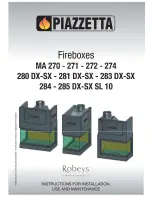
Superiorfireplaces.US.com
126718-01_D
24
6. Install three (3) screws 120° apart through the flexible vent
and into the adaptor collar just below the gear clamp to provide
additional security to the connection.
•
Route the flexible vent.
NOTE:
Ensure that the flexible vent is properly routed to pro-
vide the required clearance. Do NOT allow the flexible vent to
bend in a radius tighter than 5” (127 mm) (Figure 26, page
23). Place the internal flexible vent spacers evenly and avoid
kinking the inner vent. Support horizontal sections of flexible
vent with metal straps at 2 ft (0.61 m) intervals.
•
Install firestop/spacers at ceiling and wall penetrations.
• SF4.5VF firestop/spacer for ceilings
• SF4.5HF firestop/spacer for walls
NOTE:
See the appropriate sections and figures shown
throughout the venting section for installation requirements.
•
Attach the flexible vent to the termination.
NOTE:
Secure Flex® components can be purchased separately
and attached to bulk lengths of Secure Flex flexible vent cut
to size at the job site. Attach the flexible vent to the Secure
Flex terminations as it was attached to the adaptor (Figure
25, page 23).
NOTE:
Attach Secure Flex vent to Secure Flex terminations
only. Do NOT substitute Secure Vent® terminations or Se-
cure Vent adaptor for Secure Flex components. Secure Flex
termination and adaptor collars are a different circumference
than Secure Vent collars. Secure Flex vent has an longer center
tube to improve ease-of-installation.
VENTING INSTALLATION
Continued
FIREPLACE INSTALLATION
CHECK GAS TYPE
Use proper gas type for the fireplace unit you are installing. If you have
conflicting gas types, do not install fireplace. See retailer where you
purchased the fireplace for proper fireplace according to your gas type.
INSTALLING GAS PIPING TO FIREPLACE LOCATION
WARNING: A qualified service person must con-
nect fireplace to gas supply. Follow all local codes.
CAUTION: For propane/LP units, never connect
fireplace directly to the propane/LP supply. This
heater requires an external regulator (not supplied).
Install the external regulator between the fireplace
and propane/LP supply.
WARNING: For natural gas, never connect fireplace
to private (non-utility) gas wells. This gas is commonly
known as wellhead gas.
Installation Items Needed
Before installing fireplace, make sure you have the items listed below.
• external regulator (supplied by installer)
• piping (check local codes)
• sealant (resistant to propane/LP gas)
• equipment shutoff valve *
• test gauge connection *
• sediment trap
• tee joint
• pipe wrench
• approved flexible gas line with gas connector (if allowed by local
codes)
* An equipment shutoff valve with 1/8" NPT tap is an acceptable
alternative to test gauge connection. Purchase the equipment shutoff
valve from your retailer.
For propane/LP connection only, the installer must supply an external
regulator. The external regulator will reduce incoming gas pressure.
You must reduce incoming gas pressure to between 11" and 14" of
w.c. pressure. If you do not reduce incoming gas pressure, fireplace
regulator damage could occur. Install external regulator with the vent
pointing down as shown in Figure 27, page 25. Pointing the vent down
protects it from freezing rain or sleet.
CAUTION: Use only new, black iron or steel pipe.
Internally-tinned copper tubing may be used in certain
areas. Check your local codes. Use pipe of 1/2" diam-
eter or greater to allow proper gas volume to fireplace.
If pipe is too small, undue loss of volume will occur.
Installation must include an equipment shutoff valve, union and
plugged 1/8" NPT tap. Locate NPT tap within reach for test gauge hook
up. NPT tap must be upstream from fireplace (see Figure 28, page 25).
IMPORTANT:
Install main gas valve (equipment shutoff valve) in an
accessible location. The main gas valve is for turning on or shutting
off the gas to the appliance.
















































